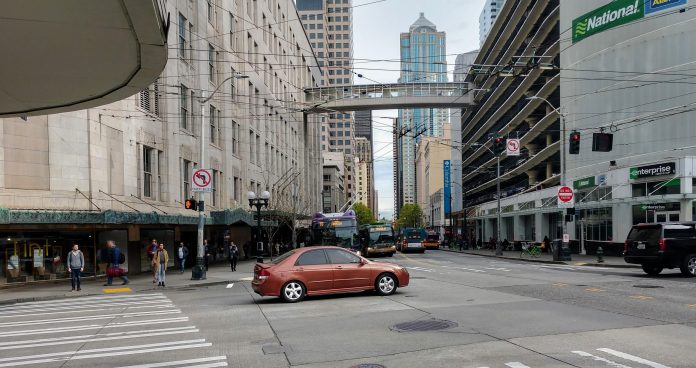
On Tuesday, King County Metro issued a notice to riders of Route 41 that a permanent revision to the route in Downtown Seattle would come on Saturday (July 27th). Instead of traveling down Stewart Street southbound, the route will hop off I-5 at Union Street and proceed toward its normal southbound routing along Third Avenue. The revision will apply at all hours, but one of the two stops will only operate during morning peak hours.
Metro says that the revision could save up to 10 minutes per trip during peak hours, a testament of how a lack of bus lanes and camera enforcement on Downtown Seattle streets strangles buses in congestion. The bus recently moved to surface streets after exiting the Downtown Seattle Transit Tunnel in March. Bus riders have complained of longer travel times. According to Metro data, the median travel times on the route at the morning peak are 15 minutes longer than other operational periods of the day.

The planned changes will benefit more than 2,100 riders in the morning, saving an average of five to ten minutes per trip. For the average weekday rider working in Downtown Seattle, that translates to 21 to 42 hours less per year stuck in congestion. Surveys conducted by Metro indicate that 79% of Route 41 riders support the change as well as 95% of bus operators who run the route.
By deleting the Stewart Street routing, riders will need to shift from stops located along Third Avenue at Pine Street and Stewart Street at 7th Avenue. A new all-day stop will be located on Union Street between 5th Avenue and 6th Avenue. Peak morning riders will also be able to use a stop under the Washington State Convention Center when the southbound I-5 Express Lanes are open. Metro assumes that the change will affect about 500 daily riders who use the two stops planned for deletion.
Riders who use Route 41 to reach destinations in Belltown, Denny Triangle, and South Lake Union can expect to walk an extra four blocks as a result of the revision. However, plenty of other transit services exist to connect for longer distances across the city center. Northbound trips will continue to use Olive Way to exit Downtown Seattle.
A revised Route 41 had been in the works as part of the One Center City near-term improvements since at least 2017, with an alternate proposal that also moved the northbound routing of Route 41 onto Pike Street. Even more dramatically, that proposal would not have served any of the route south of Union Street at all, forcing riders to transfer for many more Downtown Seattle destinations. Only the proposal to utilize Union Street moved forward.
Stephen is a professional urban planner in Puget Sound with a passion for sustainable, livable, and diverse cities. He is especially interested in how policies, regulations, and programs can promote positive outcomes for communities. With stints in great cities like Bellingham and Cork, Stephen currently lives in Seattle. He primarily covers land use and transportation issues and has been with The Urbanist since 2014.

